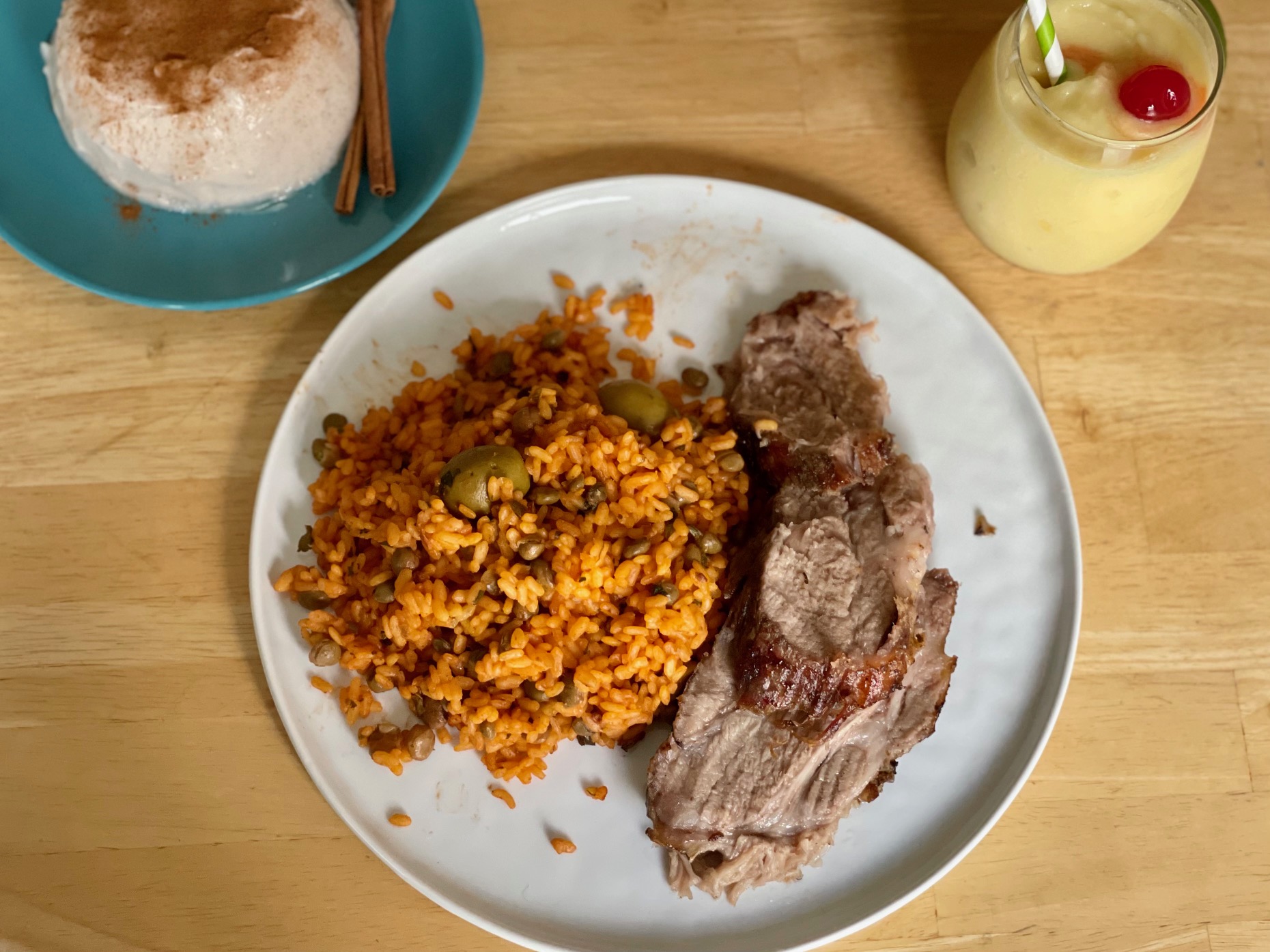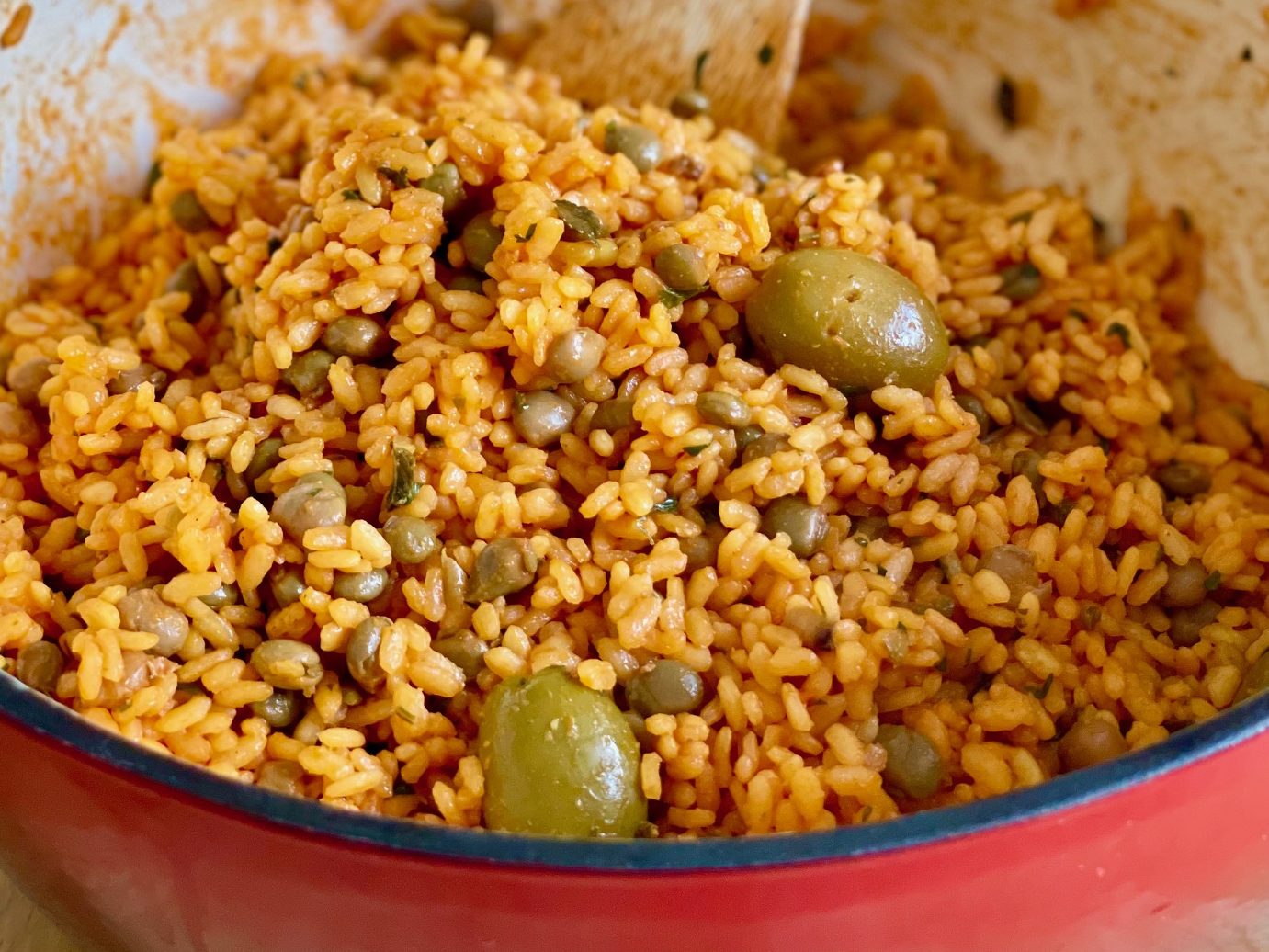Inspired by Puerto Rico

THE MEAL
(Click on the links above to jump to that part of the post!)
You might be surprised that I’m doing Puerto Rico as part of my state meal challenge, but the U.S. territories deserve love, too! Puerto Rico has a population of over 3 million people, which is more people than 17 states have! It’s been a U.S. territory since it was acquired from Spain during the Spanish-American War in 1898. As a territory, Puerto Ricans are subject to U.S. laws but can’t vote in the presidential election or elect their own representatives. The island was initially denied statehood mainly due to racism, but nowadays it seems to be a case of not enough demand. There was a vote in 2020 to see if Puerto Ricans wanted to become a state, and half of the ballots were in favor. However, only half the population participated in the vote. Another option would be for them to become an independent nation, but there hasn’t been a strong push in that direction either. So a territory it remains!
Before Europeans arrived to the island nation, it was solely inhabited by the Taino people, a hunter-gatherer culture that was largely wiped out by smallpox and slavery after Columbus and the Spanish arrived. Today the culture is a mix of Spanish, American, and Afro-Caribbean influences, which, of course, you can see in the food!
ROAST PORK
I chose roast pork as the main dish for this meal to represent Puerto Rico’s pernil. “Pernil” is the Catalan word for ham, coming from the Spanish word “pierna” for “leg.” Pork was introduced to Puerto Rico by the Spanish, and it’s hugely popular today. Traditionally, pernil is made at Christmastime with skin-on, bone-in pork shoulder, or families will roast an entire pig for parties! I couldn’t find a roast with skin and bone included, so I’m just calling this a basic roast pork.
For this recipe, I marinated the pork shoulder overnight with lots of oregano, garlic, and vinegar. I slow-roasted it at 300 degrees F. over the course of five hours, making my house smell AMAZING all day, then reverse-seared it by cranking up the temperature for the last half hour to give it a nice crispy exterior. The result was a super tender, juicy, flavorful meat that I’m thrilled to have lots of left over!
RICE WITH PIGEON PEAS
Arroz con gandules is the national dish of Puerto Rico! Rice was brought to the island by the Spanish, where it quickly became a staple food. “Gandules” are also known as pigeon peas, a kind of legume brought to Puerto Rico by enslaved Africans. Gandules and olives and all sorts of delicious flavors were added to rice to make a kind of one-pot meal–more robust and able to feed more people when making this dish for special occasions.
One of the key ingredients in arroz con gandules is sofrito, a sauce made up of tomatoes, peppers, onions, garlic, and herbs. It’s used as a base for a lot of Puerto Rican foods. It was brought to the area in the 1400s by Spanish colonists, and nowadays you can find canned Goya-brand sofrito at Hispanic markets. I was so glad to be able to find it at a store near where I live!
This rice was so fragrant with all the different flavors. It wasn’t spicy like I expected. Tomato was the strongest flavor. I’m not the biggest fan of cooked olives, so that was a little weird for me, but I liked the pigeon peas! They gave the dish an extra heartiness and a broader flavor profile. Sometimes arroz con gandules is made with diced ham, and while I loved the pork by itself, I did also enjoy chopping it up and mixing it into the rice. It tasted delicious!
VIRGIN PINA COLADA
I literally can’t read the words “pina colada” without getting the song stuck in my head.
(Also, I know there should be an ñ, but I can’t figure out how to type it out without just copying and pasting, and that’s going to take too long. Sorry!)
What do I even need to say about pina colada? I would hope that most of my readers have had the chance to sip on a refreshing pina colada at least once in their life. If not, it’s super easy to whip one up! All you need is frozen pineapple, coconut cream, pineapple juice, and lime juice! Throw all the ingredients in a blender and blend until smooth, and you get an amazing tropical drink that’s practically a dessert it tastes so good.
Pina colada means “strained pineapple.” It was invented by a bartender in San Juan, Puerto Rico, in 1945. It was such a hit that it was named the official beverage of Puerto Rico in 1978! It’s usually made with rum, but the virgin version is amazing too.
While pina colada is undoubtedly iconic in Puerto Rico, another drink I considered making was coquito–an eggnog-type drink commonly made at Christmastime. It would have been awesome, but the flavors would have been almost too similar to the dessert, and I couldn’t resist making a pina colada when given a reason to. I’m determined to make coquito someday, though! Maybe next Christmas!
COCONUT PUDDING
Please don’t judge me for how lumpy this poor pudding looks! I couldn’t find a ramekin or Jell-O mold to use, so I just went with a bowl instead. It might not be the prettiest dessert in the world, but it sure tasted good!
In Puerto Rico, this dessert is called tembleque, which means “tremble” in Spanish, because it jiggles. How cute is that??
This pudding is more like a flan in structure, made with coconut milk, cornstarch, sugar, and cinnamon. It’s creamy and almost subtly sweet. The strongest flavor is cinnamon. I always liked these kind of desserts when I lived in Paraguay because I love the light, creamy texture, and I love that it doesn’t give you an awful sugar buzz. It’s commonly served on New Year’s Day in Puerto Rico, and similar desserts are found throughout the Caribbean and South America.
Again, I’m kind of sad that it didn’t turn out looking very pretty because I didn’t have a good mold to use. Also, apparently there’s a shortage of shredded coconut right now, because I wanted to garnish the tembleque with coconut but couldn’t find it anywhere. It was such a simple dessert to whip up, so I’m going to try to make it again sometime soon, hopefully with better results!

CONCLUSION
I was introduced to some amazing new flavors with this relatively simple meal, and I loved the nostalgia of the pina colada and the tembleque! It was a nice tropical escape from the winter cold I’m dealing with right now while also helping me feel like I was still celebrating Christmas for an extended period of time this year, since most parts of this meal are traditionally served at Christmastime in Puerto Rico! I’ll definitely have to keep this meal in mind for next Christmas!
How do you think I did? Let me know in the comments if you have any suggestions for improvement, and be sure to tune in next time for my take on a meal inspired by the U.S. Virgin Islands! If that’s where you’re from, what do you think I should make to represent your state? Bonus points if you have reliable recipes or pro tips before I make the attempt! Thank you for reading!




